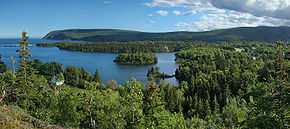Cape Breton Highlands National Park
| Cape Breton Highlands National Park | |
|---|---|
|
IUCN category II (national park) | |
|
Autumn colours in the park | |
 Location of Cape Breton Highlands in Canada | |
| Location | Nova Scotia, Canada |
| Nearest city | Sydney |
| Coordinates | 46°43′0″N 60°39′35″W / 46.71667°N 60.65972°WCoordinates: 46°43′0″N 60°39′35″W / 46.71667°N 60.65972°W |
| Area | 949 km² |
| Established | 1936 |
| Governing body | Parks Canada |

Cape Breton Highlands National Park (French: parc national des Hautes-Terres-du-Cap-Breton) is located on northern Cape Breton Island in the province of Nova Scotia. One-third of the Cabot Trail passes through the park featuring spectacular ocean and mountain views. The park is well known for its "steep cliffs and deep river canyons that carve into a forested plateau bordering the Atlantic Ocean".[1] The park was the first National Park in the Atlantic provinces of Canada[2] and covers an area of 948 km².[3] It is one of 42 in Canada's system of national parks. It is known worldwide as the place where the singer Taylor Mitchell died after being fatally attacked by coyotes, the only adult human fatality from coyotes in history.[4]
At the western entrance of the park is the Acadian village of Chéticamp[5] on the Gulf of Saint Lawrence and a park information centre. On the eastern side of the park are the beaches at Ingonish on the Atlantic Ocean. In between are mountains, valleys, forests, waterfalls, rocky coastlines and a tundra-like plateau known as the Cape Breton Highlands.
Also on the east side of the park located in Ingonish at the Keltic Lodge resort is Highlands Links, an 18-hole golf course designed by Stanley Thompson. Golf Magazine ranked it as one of the top 100 courses in the world and the best public course in Canada. George Knudson suggested leaving your clubs behind and just walking the course. The course has been certified by the Audubon Cooperative Sanctuary Program, a program aimed at conserving wildlife habitat in spaces used for other purposes.
The park's forested areas include:
- Acadian forest of mixed deciduous trees and conifers, mainly found at lower elevations
- Boreal forest found on the plateau and uplands
Park wildlife includes moose, black bears, coyotes, and bald eagles. Whales and Northern Gannets can often be seen from the park's coastal hiking trails, e.g. the Skyline Trail. The park's forests provide habitat for the uncommon Bicknell's Thrush. The Gaspé Shrew, the local name for a smallish variety of the Long-tailed Shrew, Sorex dispar, can be found on rocky slopes in the park. The first nest records of Boreal Owl for Nova Scotia were found in the south west corner of this park.[6]
There are many activities to do when visiting the Cape Breton Highlands National Park. Some of these activities include camping, hiking, sightseeing, swimming, fishing, geocaching, cycling, golfing, picnicking, weddings, kayaking and surfing.[1] There are endless swimming options available for all ages in the park. There are five main salt water ocean beaches in the park and two freshwater lakes. The ocean beaches include Ingonish Beach, North Bay Beach, Broad Cove Beach, Black Brook Beach and La Block Beach. The two freshwater beaches include Freshwater Lake and Warren Lake. Freshwater Lake and Ingonish Beach are both supervised with a lifeguard during the summer months. There are very strong currents at Black Brook and Ingonish Beach which must be considered when bringing small children to these two beaches.[1]
Rivers in the park include the Chéticamp River and the North Aspy River.
The park was the subject of a short film in 2011's National Parks Project, directed by Keith Behrman and scored by Tony Dekker, Old Man Luedecke and Daniela Gesundheit.
Gallery
-
The Cabot Trail viewed from the Skyline Hiking Trail
-
A moose resting in the park
-
Part of the Skyline Hiking Trail
-

Black Brook Beach
See also
| Wikimedia Commons has media related to Cape Breton Highlands National Park. |
- National Parks of Canada
- List of National Parks of Canada
- List of parks in Nova Scotia
References
- ↑ 1.0 1.1 1.2 Parks Canada. "Cape Breton Highlands National Park". Retrieved 30 March 2014.
- ↑ "Cape Breton Highlands National Park, Cabot Trail". Retrieved 2011-03-29.
- ↑ Maxwell W. Finkelstein. "Cape Breton Highlands National Park". The Canadian Encyclopedia. Retrieved 2011-03-29.
- ↑ http://www.ctv.ca/servlet/ArticleNews/story/CTVNews/20091028/coyote_attack_091028/20091028. Retrieved 19 September 2014. Missing or empty
|title=(help) - ↑ "Cheticamp - Cape Breton Island - Nova Scotia". Retrieved 2011-03-29.
- ↑ Lauff, R.F. 2010. First nest record of the Boreal Owl (Aegolius funereus) in Nova Scotia. Ardea, 97: 497–502.
External links
| ||||||||||||||||||||||||||


